PRASHANTI DIARY
CHRONICLES OF HEAVEN ON EARTH
Gratitude Day - New Year Celebrations: January 1st and 2nd 2007
The first day of every year is a day looked forward by every student of Bhagavan. Students who have received the gift of education from Bhagavan’s hands come every year on this day to offer their gratitude and love at the lotus Feet. What a grand way to begin the New Year.
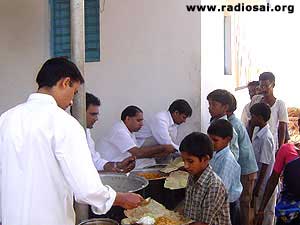 |
 |
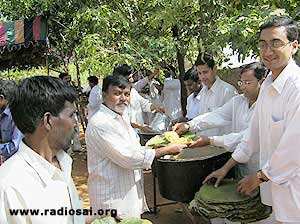 |
The former students serve the hungry.... |
|
...with love and joy |
Like every year, this year too the former students gathered in Prasanthi Nilayam on December 30 for a huge medical camp to be carried out on December 31. On the morning of December 31 when the boys had gone to the camp site for the medical seva, Bhagavan called the Warden of the Sri Sathya Sai Hostel for Senior Boys and enquired about the January 1 programme. When the Warden mentioned about the New Year morning programme to be staged by the current students of the Institute, Swami wanted to know more and asked, “What else?”
The Warden then mentioned to Bhagavan that as per His permission the Alumni are prepared to present their programme in the afternoon.
Bhagavan: “Where are they?”
Warden: “They have gone to the village for medical camp.’
Bhagavan: “Manchidi (very happy). What is the programme?”
Warden: “They have prepared the Band for a music programme…”
Bhagavan, “Where are they doing it?”
Warden: “Swami, here itself, in Sai Kulwant hall in front of You.”
Bhagavan: “Mandchidi (very happy)”
“This was a sweet indication that Bhagavan was also waiting for us. By 2.30 pm we all were seated in the Sai Kulwant Hall getting ready to welcome our Lord,” says an alumnus. Forty eight Veda boys, attired in traditional dress – saffron dhoti and angavastram, stood at the entrance of Yajur Mandir to welcome Bhagavan with Vedic hymns. As Bhagavan emerged He was welcomed by three former students, the first carrying the Poorna-kumba, the second offering a bouquet and the third placing a flower at His Feet. The joy on Bhagavan’s face was apparent on seeing His children after years of their passing out of the Institute.
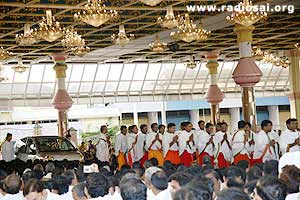 |
 |
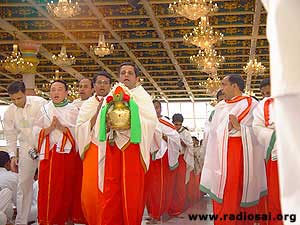 |
The procession welcomes their master |
|
The sacred poorna kumbham leading the way |
The procession then moved towards the Sai Kulwant Hall. After a complete round of daily darshan, as Bhagavan alighted from the car and walked towards the main dias He mentioned to one guest sitting there, “My boys have come to celebrate their day with Me.” One could see the proud mother in Swami.
He later beckoned the Vice-chancellor and asked him to give his opening remarks. The Vice chancellor in his speech referred to the various service activities the Alumni is busy with around the world and how they stand as role models for the current generation. After his short speech, Bhagavan indicated for the programme to begin.
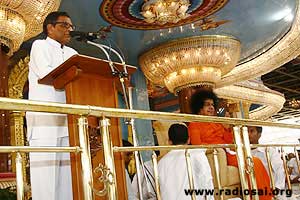 |
 |
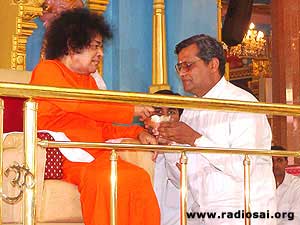 |
The Vice-chancellor gives his introductory remarks |
|
Sai accepts and blesses their offerings |
Brother Dr. M.V. V. Bhadra Rao, an alumnus from UK who was the M.C started with offering gratitude to Bhagavan for allowing His students to gather at His lotus Feet and offer their gratitude in person. At the same time another alumni went up to Bhagavan and offered a bouquet which He smilingly accepted.
Next was the cake-cutting ceremony. Though the Alumni had prepared three big cakes, they had planned to request Him to cut only one and light a candle to save Him from physical strain. But to their utter joy, after Swami cut the first cake He wanted more. So the Alumni turned the table and presented the second cake. But Swami was satisfied only after He had cut the third cake too. He then instructed, “Distribute it to all the boys”. So sweet was His concern for His children.
 |
 |
 |
Cake cutting: a delicate - and sweet - ceremony |
|
The 'seniors' band leader getting the approval |
The presentation for the afternoon was a Brass Band performance by the Alumni. In fact, it was the first time the former students belonging to the Institute Brass Band had come together to re-live their glorious days. Though many boys had touched the instruments after many years, it was a performance par excellence which moved Bhagavan’s heart.
 |
The Alumni Brass Band - A classic act |
What came next was the highlight of the New Year afternoon - an enthralling music programme, comprising of nine songs, all of them especially composed by His students.
 |
 |
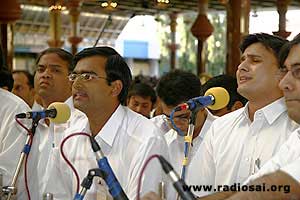 |
Getting His blessings to start the music programme |
|
They sing their heart out... |
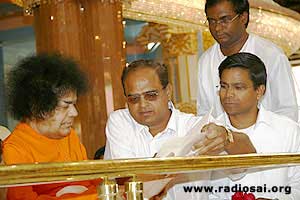 |
 |
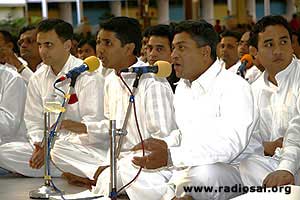 |
Alumni submit their service reports |
|
The songs are specially composed for Him... |
After every two songs, an alumnus would speak and the theme of that two minute talk acknowledged the impact Bhagavan made on His students by interacting with them and how He has been shaping their character. While this went on, Bhagavan was presented with the summary of the service activity reports from different regions like India , Europe , Middle East , Africa , America , etc. The scintillating programme ended with the Telugu song ‘Rama Katha Veenu Raaiya…” being sung by expert student singers of yesteryears. “Very Very Very Happy” – this was Bhagavan’s response as the final song ended.
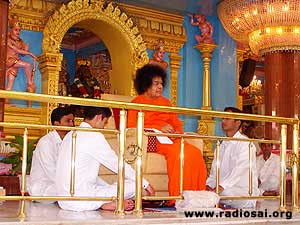 |
 |
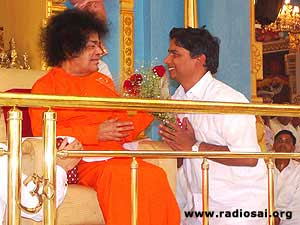 |
Listening to soulful renderings in bliss |
|
'Very Very Happy' - Swami |
Then the students prayed that Swami should bless them with His message, which He consented to do the following morning.
If January 1 was a shower of Divine Love, well, January 2 was a torrential downpour of His compassion and concern.
As promised, Bhagavan called of them on the morning of Jan 2, and by 8.15 am He was inside the Bhajan Hall. Before all the boys could walk in and settle, Swami started beckoning to Him a few boys and enquiring about their welfare. Swami was all smiles. Students are His property, He says, and seeing so many of them gathered touched His heart.
 |
 |
 |
A grand homecoming - The children with their mother |
|
She patiently listens to their prayers |
After speaking generally for a few minutes, Bhagavan started moving between the rows of students. He was recalling their names, enquiring about their lives and conferring special blessings. “It was like the good olden days” one former student remarks. “We surrounded Him, spoke to Him and received so much love.”
After He was done with all the boys, Swami sat in the middle of the Hall, near the Hanuman statue. Sitting so close to Him after so many years, the boys were absolutely thrilled.
 |
 |
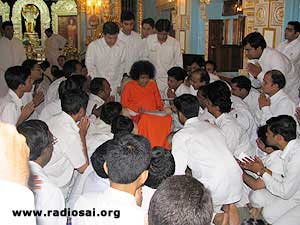 |
A chain for a fortunate one! |
|
The good old days are back! |
One student prayed to Bhagavan, “Swami please speak to us, can we arrange for a microphone?” Bhagavan consented and then spoke, softly and lovingly.
The excerpts of Swami’s message are as follows:
Mind is responsible for either bondage or liberation. One needs to exercise control. Mind is like a mad monkey and body is like a water bubble. All the worldly pleasures are fleeting ones and momentary. Know that it is the same Atmic-Self present in all. “Ekam Sat Vipraha Bhuhudavadanti”. Body is given various names like Sai Baba, etc, but God is one. He shines equally in every body.
Develop and always have self confidence. It is the foundation on which self-sacrifice, self-satisfaction and self-realization rests. Self-confidence is the base on which others are like floor, walls and the roof. Self is common in all. Never ever doubt your capabilities. Do not think whether you can do a particular job or not? Whether something will occur or not? Be confident. Positive thinking is important. With self-confidence you can achieve even the impossible. (Stressing on this topic, Bhagavan said, “Have faith that Swami is with you all the time.”)
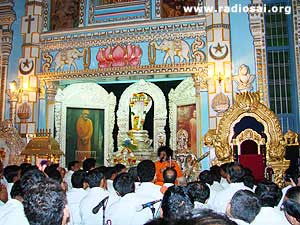 |
 |
 |
The supreme teacher guides all His students |
|
“Have faith that Swami is with you all the time.” - Baba |
Educare means developing Human values in us. Human values are Sathya, Dharma, Shanthi, Prema and Ahimsa. Put them into practice. What is the use of amassing wealth and degrees if one does not have good qualities? Good qualities give peace of mind. You can not get peace of mind by any other means. Alexander the Great understood this principle on his death bed. He conquered huge vast lands and kingdoms and amassed huge wealth. But while crossing Sindu River when he fell sick and knew he was dying, he realized he cannot take with him any of his conquests. So, he asked his generals to keep his empty hands outside his coffin on his death-bed to show to the world that even he, a great King, went empty handed on his death. The only thing which comes with you is your goodness and good qualities.
Develop Love. Peace of mind does not come with wealth but only from the good qualities one has. Develop truth and righteousness. Develop and practice human qualities and you will get everything. Help ever, Hurt Never. All are elements of God. We cannot take anything from this world. The same God is there in all. Serve people in need. Distribute blankets to those who are suffering from rains and cold. Serve the society and serve your parents.
Bhagavan then blessed the boys by saying that they could come every year on January 1 and 2 and spend the time with Him. It was a downpour of benediction that afternoon.
After His discourse, Bhagavan out of His immense concern again started conversing with the boys, answering their questions and clarifying their doubts. It was an opportunity of a lifetime, indeed.
Here is a sample of this session:
Student: Swami, how to control the growing hatred in the world?
Bhagavan: Develop brotherly love towards one and all. Know that same divinity exists in every body irrespective of caste, creed, color, and language. Develop unity and chant Swami’s Name.
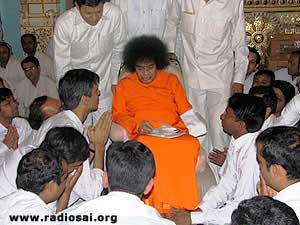 |
 |
 |
A compassionate mother, a concerned father. |
|
"Develop brotherly love towards one and all" - Baba |
Student: How do we constantly remember Swami?
Bhagavan: By practice. You can achieve anything by practice. For worldly things you practice to achieve perfection. It is the same thing.
Student: Swami, if you are happy we all will be happy.
Bhagavan: I am always happy.
Bhagavan then took this boy’s letter and said, “I am looking at you always.”
 |
 |
 |
"I am looking at you always" |
|
Almighty, mother, father, everything |
It was more than ninety minutes since Swami had come to the Bhajan Hall. Sensing that Swami would leave at any moment, the boys prayed that they be allowed to sing bhajans and Swami acquiesced to their request. For many yesteryear student-singers it was an opportunity after years; for some after decades. As Swami was listening to their soulful bhajans, He asked for prasadam to be distributed. Not only that, He gifted all students with vibhuti packets along with ladoos. The students had no words to express their heartfelt gratitude to Bhagavan. Before He left, He raised both His hands in ‘abhaya-hasta’ (blessing) benignly looking at all the students. This was not all. As He got into the car, He again looked keenly at the boys and raised His hand in blessing.
“Bhagavan’s expression of love has no boundaries. Many of us saw Him so close after a decade or more. After years, we got a chance to have a word or two with Him. Some of us had almost given up hope of another padanamaskar in our lives. All our dreams were realized today. Truly, when the Lord gives there is no limit, and we do not know how to thank Him,” say a group of alumni.
That was the glorious “Gratitude Day” on the New Year. Can there be a better beginning to the year?
Celebration of Saint Thyagaraja, January 8, 2007
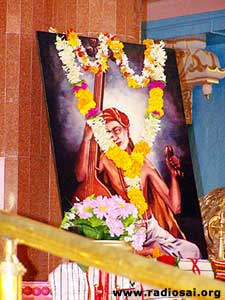 |
 |
The great 18th century poet, Saint Thyagaraja |
|
Saint Thyagaraja (1767-1847) along with his contemporaries Muthuswami Dikshitar and Shyama Shastri forms the trinity of Carnatic Music popular in the Southern parts of India . Thyagaraja, out of his unwavering devotion towards Lord Rama was inspired to compose nearly 600 krithis or songs in Telugu and Sanskrit and through this penance win the darshan of Lord Rama. These songs have today become the mainstay of any Carnatic musician’s repertoire. Bhagavan has in the past, often praised the musical quality of these compositions and has on many occasions even sung many of these compositions in His golden voice to the delight of His devotees. Saint Thyagaraja attained mahasamadhi (left his mortal coil) on the Pushya Bahula Panchami day. In his sacred memory, the Thyagaraja Aradhana festival, a week long music festival is conducted every year in the birth place of Thyagaraja at Thiruvvaiyuru in the state of Tamil Nadu, with thousands of singers and hundreds of musicians singing his most famous compositions, the Pancharatna Kritis in unison, with the accompaniment of a large orchestra of violins, flutes, nadhaswarams, mridangams and ghatams on the Bahula Panchami day.
At Prasanthi Nilayam, it is the good fortune of the students of the Sri Sathya Sai Mirpuri College of Music to celebrate this festival in presence of Lord Sai Rama, the very God who was adored by Saint Thyagaraja.
This year the Bahula Panchami Aradhana was observed on January 8 at Sai Kulwant Hall. After obtaining Bhagavan’s blessings, the students commenced the program with a song in adoration of Lord Ganesha, Sri Ganapatini Nee in ragam Sourashtram set in Aditalam followed by three of the pancharatnas, the first one being, Jagadananda Karaka in Nata ragam followed by Sadinchane in Arabhi Ragam and the next being Endaro Mahanu Bhavulu in sri ragam, all of them being set to Aditalam. The program ended with a veena duet where in the song was Enta Vedukondu in Saraswati Manohari ragam set to Adi talam. Swami was very pleased with the performance and indeed was seen singing a few stanzas along with the students. At the end of the programme, Bhagavan blessed the participants and presented them with clothes.
 |
 |
 |
Students render Saint Thyagaraja compositions... |
|
...full of love and devotion at His Lotus Feet |
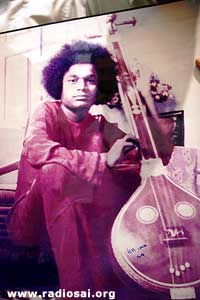 |
 |
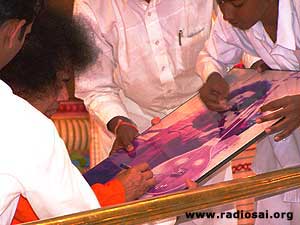 |
The Source of all music |
|
Sai autographs His own image |
Annual Sports and Cultural Meet, January 12 th
One of the most important, electrifying and entertaining days in the Prashanti Nilayam calendar, the inaugural function of the Annual Sports and Cultural Meet this year too did not fail to enthrall and delight one and all. The entire Sports Meet can be easily compared to one of the most delicious dishes that can be ever served. Central to its recipe are the ‘spices’ of precision, imagination, elegance, passion and most importantly Love for our Beloved Lord. The event is totally in keeping with the most quoted adage of all times- “Life is a Game, Play it”. All the tremendous skill that lies dormant in the students culminates in a performance that makes the spectator anxious not to even as much as bat an eyelid and risk missing the action. The display caters to a variety of tastes - be it thrilling daredevilry, or edge-of-the-seat acrobatics, or elegant dance and music presentations.
The proceedings began in the morning with Bhagavan coming out at around 7:00 a.m. to the grounds of Sri Sathya Sai Hill View Stadium. The first event was the march past of the various campuses. Students from the first standard to final year post graduate, all march in front of the Lord. Dressed in regal and colourful dresses, all the students marched forth offering their salute to the Lord as they passed the dais. It was as if every soldier of the entire Sai Army saluted the Chief of this strong Sai Army. With a twinkle in the eye and a graceful movement of His head, He acknowledged every contingent as they passed by, as if to tell them that everything had come out right just as He had seen it in the various practice sessions (Swami had graced the grounds various times during practice sessions of the meet).
 |
 |
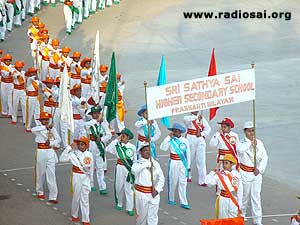 |
The Sai Army marches Past their Chief |
The oath ceremony and the torch lighting ceremony were the next to line up in the sequence of events. That done, the stage was all set for the day’s events. “Watching all this, the feeling welled up in my heart,” says a student, “that here lies a journey where the means always stand taller than the ends. The weary weeks of conceptualization, the intense days of practice, the tense hours of final preparation, all coming together in flawless precision as our offering to the Lord!”
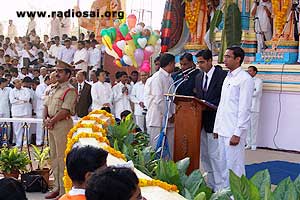 |
 |
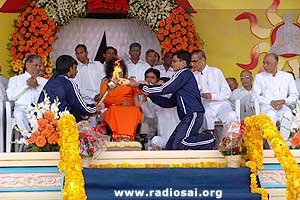 |
The Oath-Taking Ceremony led by the Institute Captain |
|
Swami lights the sports meet torch |
The opening performance was by the Brindavan campus of the Institute who began their show with paragliding. The skill and acumen for this challenging fete is most difficult to master. Watching those fliers in the sky, who had a “bird’s eye view” of everything around, was delight mixed with tense moments for the spectators. Then in all elegance they swooped down for a comfortable landing. The boys who performed the stunts were called over by Bhagavan and given trophies and a well-earned pat on their cheeks.
 |
 |
 |
The Paragliders soar... |
|
...from new heights to achieve their goal |
Then the students on motorbikes were soon to follow with some breathtaking stunts, speedy crisscrosses and some high flying ramp jumps. Then followed a cricket drill with students dressed in the attires of the various cricket playing nations showing how games and sports brings together people of various beliefs and cultures and fosters unity in diversity.
 |
 |
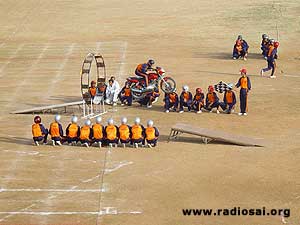 |
The trailblazers zoom across the ground |
|
As fast a bullets! |
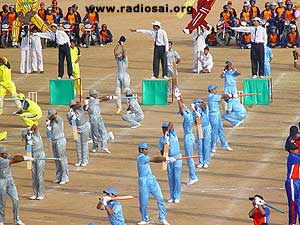 |
 |
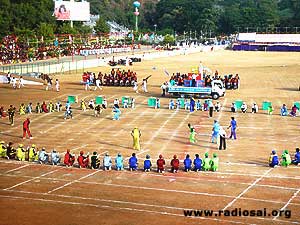 |
All nations... |
|
...playing in harmony |
The Prasanthi Nilayam campus was the next to follow. The presentation began with a dance in praise of Lord Ganesha. At the back was a dazzling effigy of Ganesha in a dancing posture set on a globe. Indeed, so masterfully was it made that it even seemed to join the dancers in their performance.
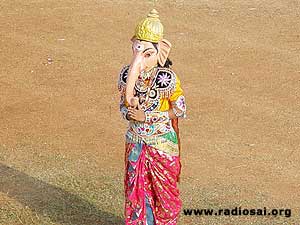 |
 |
 |
The 'Prasanthi Ganesha' |
|
Ganesha dance presented before the Divine |
Following this, there was a fantastic display of Chinese and Indian Martial arts and some creative basketball mingled with gymnastics. A daring display of stunts and showmanship on jeeps was the next item. They demonstrated the truth of the maxim “Nothing dared, nothing done”.
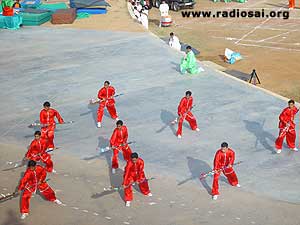 |
 |
 |
Demonstrating the ancient Chinese martial arts |
|
The vibrant Indian martial arts from the state of Punjab |
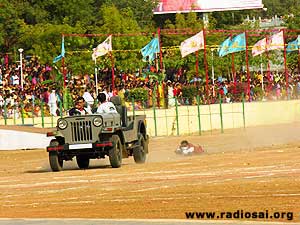 |
 |
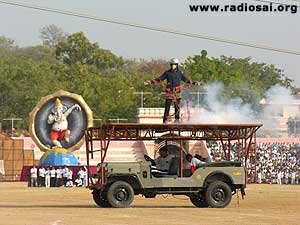 |
The daredevils motto:... |
|
...'Nothing dared, nothing done" |
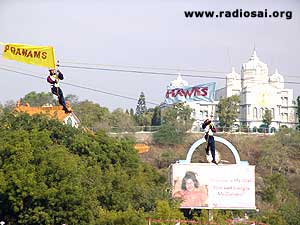 |
 |
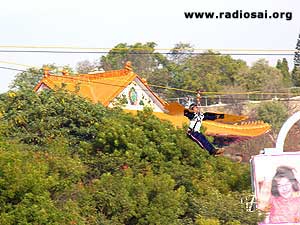 |
High above the ground |
|
Look Ma, no hands! |
One of the most exhilarating spectacles of the day was carabining down the rope from the hill onto the ground over the heads of spectators. The students went a step further to include the slicing of targets placed in their path as they roared down into the ground. It was such a tremendous feat of concentration and courage with their minds fixed on their goal, the performers transcended all bounds of fear as they descended from several feet up in the sky placing their faith on a slender rope.
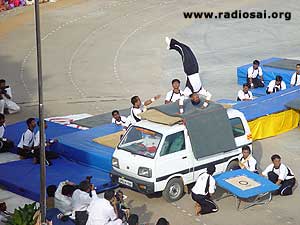 |
 |
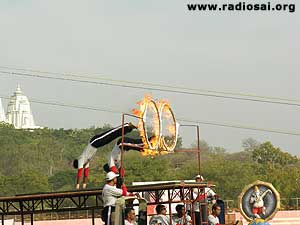 |
A scintillating display of athleticism,
rhythm and mental strength |
|
Falling is the least of our worries! |
Nay! The faith rested in Him, who was always there to brush aside adversity and ward of the winds of fear. Faith born out of experiencing His Presence in every aspect of their lives and more particularly in every endeavour of the Sports Meet guiding the students visibly and invisibly. It is at times like this that we become aware of how every moment of our lives he is expressing His perfection and beauty.
The afternoon session saw Bhagavan being welcomed by the students of the Sri Sathya Sai Primary School by an innovative caterpillar formation by students trained in acrobatics. This team of acrobats later put up a fantastic display of their skills performing gymnastics not only on the ground but also on poles.
 |
 |
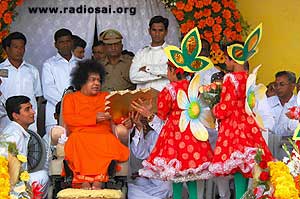 |
Tiny tots seek His love and blessing |
|
Commencing the afternoon session |
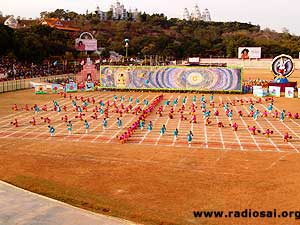 |
 |
 |
The magic of pink and blue |
|
Could we see this from space? |
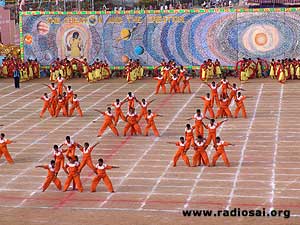 |
 |
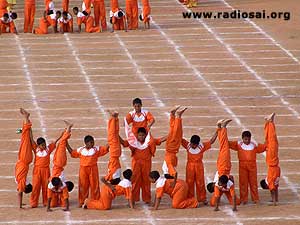 |
A display of synergy... |
|
...and concentration |
 |
 |
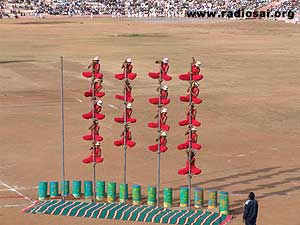 |
A display of balance and flexibility |
|
Relaxing above the malkham |
The girl students exhibited a number of dance formations. Their colourful costumes and the imaginatively arranged sequences made for a pleasing sight, which were greatly appreciated by the audience.
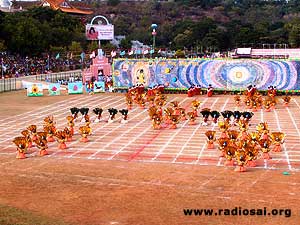 |
 |
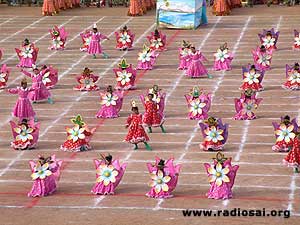 |
Beauty and symmetry at its very best |
Some of the formations were so breathtakingly beautiful that at times the response from the audience was an audible gasp as they took in the elegance of the display. The students also treated the audience to a daring feat of eye-catching formations on a grid 40 ft high. All this made for a highly entertaining programme, as always from the children of the Sri Sathya Sai Primary School . They concluded their presentation by serenading to their Lord with the song “Madhura Mohana Ghanashyama”.
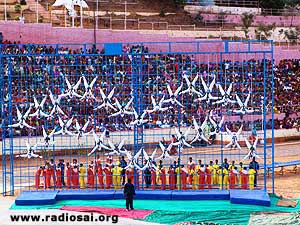 |
 |
 |
Can you believe, they are just twelve years old or less! |
After this colourful presentation by Sri Sathya Sai Primary School , the students of the Anantapur Campus of the Institute, commemorating the completion of 25 years of the formation of the Sri Sathya Sai Institute of Higher Learning, presented a programme on the theme: “The Sri Sathya Sai System of Integral Education.”
The inaugural item highlighted the auspicious beginnings of the Institute in the establishment of a College for women at Anantapur in 1968. The Sri Sathya Sai System of Integral Education aims at the development of every aspect of human life – the physical, the emotional, the intellectual and the spiritual – which when integrated leads to the total blossoming of the individual personality. This idea was well brought out in the programme presented by the Anantapur Campus.
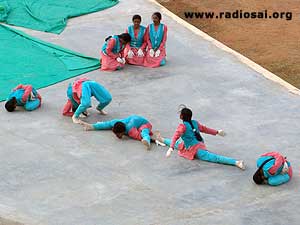 |
 |
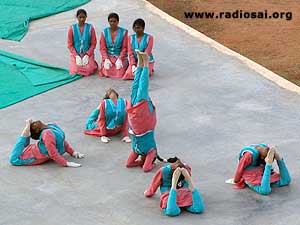 |
Extremely difficult asanas... |
|
...made to look simple |
A day in the life of a Sathya Sai student was depicted, beginning with the first activity that every student engages in after chanting Omkar and Suprabhatam; namely, Yogasanas. Yoga helps the students to calm the agitations of their minds to achieve the equanimity which is the aim of Yoga. Different asanas were performed with perfect co-ordination and balance. The Sahasrara or Thousand Petalled Lotus – the abode of the highest consciousness in man – was beautifully shown, with the Bindu – where God resides – being symbolized in the mudra of an enlightened person. The girls also demonstrated a few difficult asanas that only an adept practitioner can perform.
Two academic sessions of the Institute were depicted very smartly with a chair drill. The unique relationship of mutual love and respect between the teacher and the taught in the Institute was brought out, followed by a representation of the values of discrimination, equanimity and self-confidence that are required in the pursuit of secular knowledge.
A sound body leads to a sound mind. At Sri Sathya Sai Institute of Higher Learning, the curriculum is not confined only to the academic subjects but also to the physical and spiritual domains. Hence, the daily schedule has time set apart for sports and games too. This was shown through skating, a badminton drill, and a variation of rope and pole malkam.
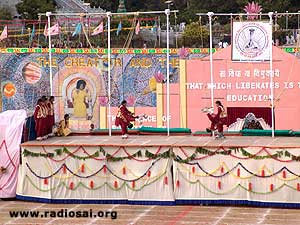 |
 |
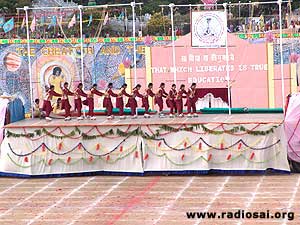 |
Commanding speed and energizing control... |
|
...on a thin board of just 12 feet by 40 feet! |
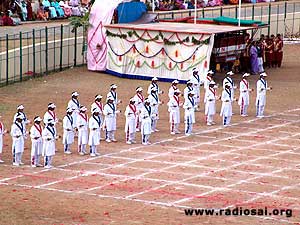 |
 |
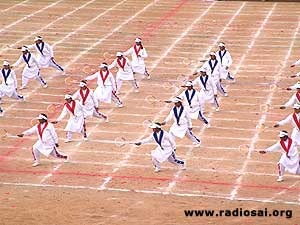 |
The Blue Strikers and Red Smashers |
|
Displaying various Badminton strokes |
The skaters performed some acrobatic and gymnastic stunts on a board that was just 12 feet by 40 feet in size. The badminton drill was a demonstration of the different strokes used in the game of badminton, ending with an imaginary match between the Blue Strikers and Red Smashers. This was followed by an exciting and breathtaking display on the poles and ropes that had a height of nearly 27 feet from the ground. It was an amazing display of various asanas on moving vehicles!
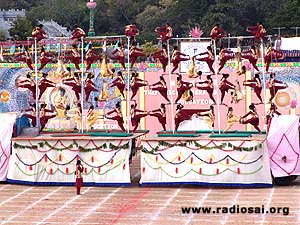 |
 |
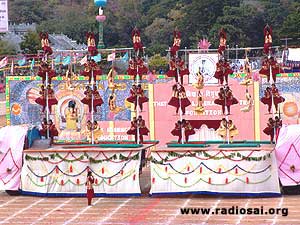 |
A strong mind... |
|
...overcomes dizzying heights |
Social service is an important facet of the curriculum of the Institute. Bhagavan says that the essence of education is service. The truly educated must share their knowledge and skill through selfless service, and thus repay their debt to society. To depict Social Service, the students performed a drill with baskets and shovels. One part of this drill very innovatively showed a house under construction recalling how a few years ago, as part of a Service Project, the girls had built 50 houses at Raptadu, a few miles from Anantapur. The Annual Grama Seva programme of the Institute, wherein all the students go from village to village distributing food and clothes, was also represented.
Since extracurricular activities like music, dramatics and dance, etc., are equally necessary to create in the students a comprehensive understanding of the culture and traditions of the country, the concluding part of the programme had the Dancing Dolls from Anantapur singing in praise of the Lord of the Universe who has started a University to establish peace in the world.
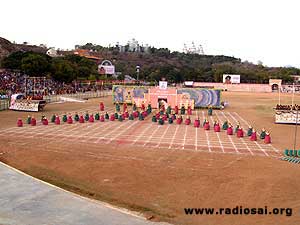 |
 |
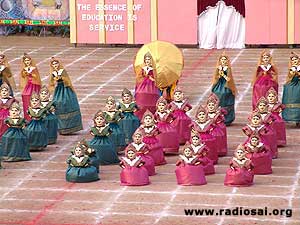 |
Portraying Indian cultural dance |
The fully equipped products of the Sri Sathya Sai System of Integral Education were then presented before the Revered Chancellor, Bhagavan Sri Sathya Sai Baba. The grand finale song was played extolling Bhagavan and the students and teachers paid a grateful tribute to Beloved Bhagavan for the wonderful gift of Educare that He has given them. The students reflecting the thought of all present there, stood in sincere prayer at the end thanking Him for helping all beat all the challenges that had to be overcome to make such a majestic presentation possible. Man gains so much from challenges and learns lessons that could be taught in no other form. Challenges brings the best out of man as one poet said so beautifully “The brook would lose its song if God removed the rocks.”
 |
 |
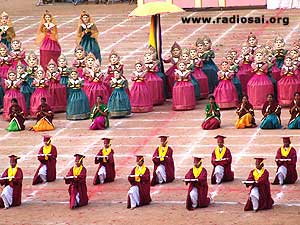 |
Armed with Educare... |
|
...they plunge into the world to make a difference! |
Around fifteen hundred students, two hundred teachers, and a host of administrators across the three campuses working in unison – caring not whether it is night or day – whether the limbs ache or the belly growls. ‘Challenging’ is not good enough for them - they have set their sight only on the ‘impossible’; they are out to testify the veracity of the power of faith – the adroitness that concentration can elicit and the will that knows not how to bend in defeat. And all this for just one moment of that one day - for the smile on that one face whom we all know simply as Swami. One can only stand and admire that Divine Force and pay our salutations to that Supreme Power of devotion to Bhagavan that inspires these Sai soldiers to march on triumphantly and display their mettle in a daring and dazzling display of prowess in spite of all odds.
Bhakta Prahlada – Drama presented by Brindavan campus students on 14 th January 2007
The mind is the key for the lock to the Heart. If a key is inserted in a lock and turned left, the lock is closed; when turned right, the lock is opened. Similarly, when the mind is turned outward towards the world, man is lost in bondage; when he turns the mind inward and has the vision of God in his Heart, he becomes free and is redeemed. The story of Bhakta Prahlada illustrates both the pitfalls of turning the mind away from God, and the kingdom of heaven that awaits us when our life is dedicated to the love of God. This story was depicted in a drama titled “Bhakta Prahlada” put up by the students of the Brindavan campus of Sri Sathya Sai Institute of Higher Learning on the evening of January 14 at Sai Kulwant Hall.
Hiranyakashipu, the powerful demon king wins a boon of invincibility from Lord Brahma and comes to believe that he is more powerful than Lord Vishnu and ordains that henceforth all worship is to be offered only to him and none else. This is so symbolic of our present day society where we have supplanted adoration of the Divine with a hedonistic self-centered existence. Developing this analogy further, the play portrayed through a dance sequence how Hiranyakashipu won mastery over the five elements.
 |
 |
 |
Hiranyakashipu in pursuit of the boon of immortality
|
|
Reigning control over the elements |
By understanding the first element, the expansive and mysterious Space, he became free from fear of failure. By comprehending the second element, the fast and furious Wind, he stilled fickleness. By knowing the third element, the blazing Fire, he succeeded in controlling anger and the pangs of hunger. By realising the fourth element, the flowing Water, he quenched the thirst of passion. And by experiencing the fifth element, the inert and heavy Earth, he overcame inertia and sloth.
 |
 |
 |
More powerful than God |
|
'I am the only God' - Hiranyakashipu |
Hiranyakashipu’s son, Prahlada, on the other hand, was the faithful devotee of the Lord Narayana, initiated into His worship at birth by none other than Sage Narada himself. Prahlada mirrors his father’s achievements, but by complete surrender to the Lord.
He is fearless because he is assured of the Lord’s protection. He is steady in his faith in the Lord’s might. Fire cannot burn him, water cannot drown him, a fall to the Earth cannot hurt him! All the five elements become benevolent to him because of his devotion and love for the Lord. Ultimately, it is devotion and love that overpowers arrogance and might.
As Prahlada comes of age, his father decides that it is time to place him under the tutelage of able teachers and for this, he chooses Chanda and Amarka, the sons of Shukracharya, the Guru of the demonic clan. The teachers train him in the scriptures, but at the back of their mind is the instruction from Hiranyakashipu that his son should recognize that there is no God greater than his own father.
 |
 |
 |
The teachers, Chanda & Amarka... |
|
...take Prahlada to school |
When he returns to the palace, the king is eager to see the progress Prahlada has made. To his consternation and to the dismay of his teachers, Prahlada instead reaffirms the primacy of Lord Vishnu above all else. Blinded by anger, Hiranyakashipu orders that his son be destroyed. The royal soldiers try all means – the tender child is thrown down a mountain, when that failed, he was thrown into the ocean and when he emerges safe and sound, he is thrown into the fire. At this, the God of Fire himself carries him out of the flames and places him on safe ground.
 |
 |
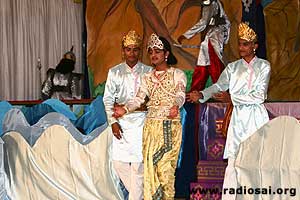 |
Water cannot drown him... |
|
...instead it submits to him |
 |
 |
 |
Fire cannot burn him... |
|
... it surrenders to the true devotee |
But, when ego has taken root in man, it drives out all reason and feeling. Hiranyakashipu confronts his son and asks him to prove the existence of God. Prahlada calmly tells him that God is everywhere - it cannot be said that He is present someplace and does not exist elsewhere. This enrages Hiranyakashipu and he advances towards a pillar challenging Prahlada to show that God exists in that pillar too.
The time had now come for the ignorance in Hiranyakashipu’s heart to be removed once and for all. There is a thunder clap and the pillar splits open and out emerges a terrible man-lion form. This form of Lord Vishnu is worshipped as Lord Narasimha (Nara-Man; Simha-Lion). This terrifying being proceeds to take Hiranyakashipu into its lap and begins to tear out his entrails. However, it is not Hiranyakashipu who is annihilated. It is his ego and ignorance that is destroyed. In his dying moments, Hiranyakashipu realizes that there can be none greater than God and nothing greater than devotion towards Him, and he offers his salutations to Him as he breathes his last.
 |
 |
 |
The Lord assumes the unprecedented form of Lord Narasimha
|
The reason for this unique manifestation of the divine is very fascinating and has to do with the boon awarded to Hiranyakashipu by Lord Brahma whom he had pleased with his arduous penance. He had sought from him the boon of immortality and Lord Brahma in His wisdom granted him that he could not be killed by any animal, man, god or demon either at day or night, whether indoor our outdoors. That is why the Lord assumed a form that could not be said to be any known being, He attacks him at the twilight hour which is neither day nor night, and slays him on the porch of the palace which is neither indoor nor outdoors.
There is yet another fascinating aspect to this manifestation. In the last scene of the play, after the little Prahlada witnesses his own father’s death, he falls at the feet of the being and hails Him as Lord Narayana. That unflinching faith in the Lord to be able to recognize him in any form under the most trying circumstances – this was the ultimate test from God and young Prahlada passed with flying colours to be immortalized as one of the foremost devotees of the Lord to inspire mankind for all time to come.
 |
 |
 |
With the mission accomplished... |
|
...the Lord is with His dear devotee |
After the drama, Bhagavan lovingly gathered the boys near him for photographs. All the students involved, the actors, those who gave background music, the costumes department and the sets boys all were given the same pat on their backs for their grand effort. And as if to show, that the Lord had no resentment in His Heart towards Hiranyakashipu, Bhagavan called the boy who played the part of Hiranyakashipu and said to him, “You are a good boy”! Anuj Sharma, who played Prahlada was blessed with a chain materialized from the Lord’s Hands.
 |
 |
 |
A prize like no other! |
|
Nothing else is more rewarding! |
The students and teachers of the Brindavan campus were indeed fortunate to be blessed to present this story of devotion and faith in Bhagavan’s presence. Fortunate not just to win His beaming appreciation after the drama and words of praise the following day in His Discourse, but also to go through the sweat and toil that goes into making such a wonderful event possible. For, this was an effort for the highest purpose, to please the Lord Himself.
The drama had been conceived six months earlier to allow the actors to ‘get in to the character’ of their role. Work on the massive and elaborate sets too began at that time. The story had to be presented in such a way as to make it memorable and at the same time drive the sacred message home. A lot of thought went into the various aspects of the dance that portrayed Hiranyakashipu’s conquest of the elements like the manner in which the concept had to be brought out, the form of dance, the nature of instruments to be used for each of the five elements, the kind of music to be used and so on.
For example, in the case of the element Akasha or Space, the attributes of the element were first listed out: expansive, mysterious and characterized by deafening sound. This helped in choosing the right form of dance, the appropriate colour for the costumes and the right combination of instruments for the music. How to conquer this noise? Through inner silence. And Space was linked to the quality of Fear. This was the basis for the lyrics and the expression for the dance. Similarly, the element Fire was linked to Jataragni, the fire inside our body, which is used for digestion; and hence came out the idea that Fire can be conquered by controlling hunger. To bring in the element of realism, in the scene where Prahlada is thrown down the mountain, a substitute actor actually jumped down fifteen feet into a crash pad to create the effect. The thunderous applause when Prahlada emerges unscathed after this scene was testimony to the grip they had on the audience. All in all, kudos must go out to the students and teachers of the Brinadavan campus for presenting such a wonderful drama that would have kindled in all present an aspiration to be like Prahlada and achieve that ultimate state of total surrender to the Lord.
Sri Krishna Rayabaram – A Drama presented by Prasanthi Nilayam campus students on January 15, 2007
 |
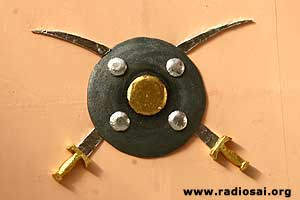
|
| |
The eternal battle - good and evil |
The Mahabharata is an epic revered in millions of hearts even today in India because it is a timeless representation of the eternal conflict between the forces of the good and righteous on one hand and the dark forces of the evil vices on the other. Like the blind king Dhritarashtra who ruled from Hastinapur, the mind is blinded by ego, greed, hatred, desire and limitless ambition. Representative of these vices are Suyodhana, the eldest son of Dhritarashtra, (the name Duryodhana by which he is more commonly known was given later to represent his evil nature), Suyodhana’s ally Karna, his cunning uncle Shakuni, and his brother Dushyasana.
So utterly blinded he is by these vices that he no longer pays heed to the advice of buddhi (intellect) and viveka (discrimination) represented by the wise minister Vidura and grandsire Bheeshma. These are the mind’s eternal companions who help him discriminate through the various crossroads of life. They receive their strength and inspiration from the supreme fountainhead of awareness which is the conscience. The conscience prods and guides the mind, but more often than not, the confused mind is assailed by so many desires, that it is unable to distinguish the good from the bad. To such a mind, even the sight of the cosmic form of the Lord is a blinding, scorching light. He prefers to keep his blindfolds on and not confront reality. That is the attitude of Dhritarashtra. This is the immortal story told in the Mahabharata, one of the most revered scriptures in India.
 |
The preamble done, the drama is set to stage with His blessings |
The Post Graduate students of the Prasanthi Nilayam campus of the Sri Sathya Sai Institute of Higher Learning depicted an important episode from this sacred epic titled “Sri Krishna Rayabaram” on the evening of January 15 at Sai Kulwant Hall on the occasion of Makara Sankranthi. In this episode, Lord Krishna undertakes a peace mission on behalf of the Pandava camp as a last attempt to dispel the war clouds that had been gathering. The drama starts off at that point in the story after the Pandavas, the much persecuted cousins of the Kauravas, the sons of Dhritarashtra, finish their thirteen years of exile. The Pandavas dutifully send an envoy to Hastinapur with the message to return Indraprastha that rightfully belongs to them but the messenger is humiliated in the court. Suyodhana sends a strong message in return to fight and get back their kingdom. War is now imminent and both the camps have started preparing.
The opening scene is set in Dwaraka, at Krishna ’s palace. Krishna is taking rest when Suyodhana comes and proudly occupies the seat at the head of Krishna . Arjuna arrives a little while later and humbly waits with folded palms for Krishna to awake. Both are in the palace for similar reasons – seeking Krishna ’s help in the impending war. As Krishna gets up, he notices Arjuna first and enquires as to the reason of his arrival. Suyodhana makes his presence felt and asserts his right to petition Krishna first as he had arrived there first. Krishna offers them a choice between Himself and His army. Arjuna chooses the Lord while Suyodhana is delighted to see Arjuna make this apparently foolish choice and gladly takes Krishna ’s army.
 |
 |
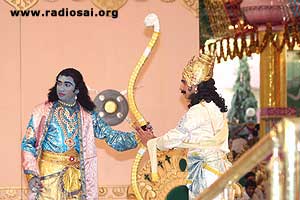 |
An unexpected visitor at Krishna's residence |
|
Arjuna chooses the Lord over His army |
The next scene has the all knowing Krishna preparing the Pandavas for war. Virata and Drupada enter the scene and put forth the argument for the necessity of the war. Krishna then explains that peace can still be the best solution. Having convinced the Pandavas and Drupada, after a vehement argument, Krishna decides to go to Hastinapur as the peace messenger of the Pandavas as a final attempt to stave off a disastrous war. The Pandavas are apprehensive that their beloved Krishna may be in mortal danger in the hostile environment of Hastinapur. But, He lays their fears at rest and proceeds to the royal court at Hastinapur.
 |
 |
 |
War or peace - The pandavas deliberate with Krishna |
|
Krishna advocates the principle of peace |
After this is a scintillating dance portraying the joy of the people of Hastinapura on Krishna's arrival.
 |
The people of Hastinapura dance in joy at Krishna's arrival |
At the palace, Krishna accompanied by Bhishma is led to the chamber where Dhritarasthra, Suyodhana, Shakuni, Karna, Dushyaasana and Vidura are waiting to welcome Him. Krishna refuses the offer of staying and dining with Suyodhana stating that he has come as a peace ambassador. The cunning Shakuni says that this only shows His bias against the Kauravas. But Krishna deftly tackles this taunt saying that if the Kauravas respected Him they would have chosen Him over His army and thus makes it final that He will not stay with them. He decides against established precedent to refuse the royal hospitality and instead stays with the minister Vidura.
 |
 |
 |
Krishna - the ambassador of peace |
|
The crafty Shakuni playing his tricks |
The scene at Vidura’s residence is quite moving, for Vidura, recognizing Krishna ’s divinity is very devoted to Him. So overcome by emotion is he at his fortune in playing host to the Lord that while offering fruits to Him, he peels bananas and then absentmindedly feeds Krishna the peels which Krishna lovingly accepts.
 |
 |
 |
Vidura, drowned in devotion, offers the banana peel, not the fruit, to his Lord |
|
"It is not in the act itself, but the devotion behind it, that truely matters to me" - Krishna |
The following day at the court, Vidura and Bheeshma try to explain to Dhritarashtra that he must take the arrival of Krishna as a peace ambassador seriously. Suyodhana warns them that, if Krishna exceeds His limits, he will not hesitate to make Krishna a prisoner. Bhishma and other elders present are outraged at this show of disrespect to the Lord and warn Suyodhana that this arrogance would prove costly.
 |
 |
 |
An angry Suyodhana does not want peace |
|
Bhishma warns the Kaurava princes |
The next scene beautifully captured the dilemma raging within Dhritarashtra as his conscience battles with his filial attachment to Suyodhana. This was done by using Dhritarashtra as a metaphor for the mind with the evil forces represented by Suyodhana, Karna, Shakuni and the good forces represent Vidura, Bheeshma and Drona each pulling him towards their camp. But, in the end, it is the evil forces that prevail and this was later to spell disaster and much grief to the blind king.
 |
The ignorant man in an eternal fight between good and evil |
The denouement of this episode takes place in the court of Dhritarashtra where Krishna puts forward the peace proposal stating that peace would be the best solution to the feud in the family. The consequences of war would be disastrous for both the parties. In order to maintain peace, He reasons with Suyodhana to at least sanction five villages, one for each of the Pandava brothers.
 |
 |
 |
The evil is more enticing and easy... |
|
A weak mind finds comfort in vices |
Suyodhana rejects the offer outright and tells Krishna to convey the Pandavas that if they had some courage and strength, they would come into the battlefield to fight it out. Krishna threatens Suyodhana that he and his entire family would be decimated and even his mother would not have enough tears to cry. This enrages Suyodhana who in a fit of rage orders the palace guards to bind Krishna and throw Him into the prison.
 |
 |
 |
Krishna puts forward the peace proposal... |
|
...only to be rejected by thoughts of war |
As the guards advance to capture the unarmed Krishna , suddenly they see a profusion of Krishnas . This was the Vishwaroopa (cosmic) form of the Lord as the one who is present in all places and in all beings. Was it possible then for an ordinary mortal to then bind him through force.
 |
 |
 |
As the guards advance... |
|
...Krishna reveals His Cosmic Form |
This was the final electrifying scene of the drama that drove home two important messages: one, that the there is no earthly power that can claim victory over the Lord save the power of sincere love and prayer; second, the most valuable and permanent relationship is the one we cultivate with God, that alone brings lasting joy.
At the end of their presentation, the performers gathered near Bhagavan even as He happily beamed His approval. They gathered near Him for the coveted photographs and His words of appreciation. Bhagavan had every reason to be proud of His students’ performances. Not only was the caliber of the thespians one of very high order, the intellectual content of the play, the powerful dialogues - all reflected the high academic standards of the Institute. The Telugu verses from the ‘Pothana Bhagavatham’ as well as the verses in Sanskrit created the right atmosphere to engage the attention of the audience. The magnificent props for the royal court at Hastinapur too did their part in making this presentation an unforgettable experience for the devotees who had gathered in Sai Kulwant Hall on that sacred day.
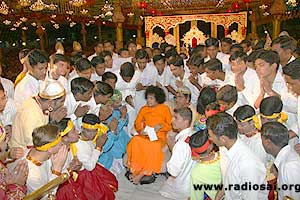 |
 |
 |
A well-deserved reward |
|
The memory they will ever cherish |
January was truly a month of breathtaking events in the sporting, thespian and musical fields. What a privilege for all concerned, both the performers and spectators, that all the effort was made not for personal achievement - but for God. The joy that is won comes from Sai, and radiates not only in our hearts but all over the world as expressions of His love. Prashanti Diary is documenting and elucidating the details of His Story and hopes that you, dear reader, will be inspired and amazed by the tales told therein.
Until next month, Sai Ram.
- Heart2Heart Team. |



